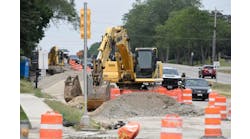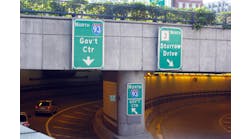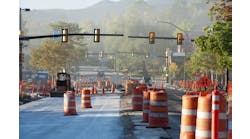America’s Great Plains states are largely, if not exclusively, agricultural. They literally feed the nation.
In this way, their economic health is inextricably tied to that of the country as a whole; though not a center of financial industry or global technological advancement, the Great Plains could be considered the beating heart of the country. For this first in a series of 2016 Region Reports, Roads & Bridges reached out to departments of transportation in three such states—Nebraska, Kansas and Oklahoma—in order to assess the state of their transportation infrastructure and learn what’s on the horizon as the 2016 work season gets underway.
Finding the sweet spot
The advent of the Fixing America’s Surface Transportation, or FAST, Act has meant that state DOTs are now able to take, with more confidence than in previous years, the long view with regard to project planning and general maintenance schemes. In Kansas, such planning begins with data.
“We’ve got a robust and data-intensive road maintenance system,” Jerry Younger, deputy secretary and state transportation engineer for the Kansas Department of Transportation (KDOT), told Roads & Bridges. “We collect condition data every year for every mile of the state system. We have a state highway system that’s just under 10,000 center-lane-miles, and the overall system [including local and county roads] is another 130,000 center-lane-miles. With the data, we can optimize our project planning and get the biggest bang for our buck. That’s how we scope if a road project will be, for example, a seal or an overlay or a reclamation, or just a patching project. We’ll also filter that data through our experience with a given road and ultimately come to a decision that way.”
KDOT realizes approximately $1.2 to $1.4 billion per year in revenue, of which $380 million will be federal aid resulting from the FAST Act. Younger expects 2016 to see more than $600 million in letting, the balance of which, against the federal portion, will be derived from a mixture of state-derived fuel and sales taxes as well as vehicle registration fees. How this will translate to qualitative and quantitative results, for both road rehabs and, more notably, bridge issues, is the simple means of finding what Younger calls the sweet spot.
“A lot of the bridge progress is happening on our local system,” Younger said. “KDOT has always shared a portion, typically 20%, of its federal aid with local counties and cities. A lot of that money goes toward bridge rehabs. When we drill down [with our data], we’ve found a sweet spot in the characteristics of those local SD/FO bridges, based on size and type. What most of them have in common is that they are under 50 ft in length. So we have targeted those bridges, with an $11 million plan. We reached out to local partners and offered dollars to replace or rescue, or, if necessary, even close those bridges. We have funded over 70 projects that took bridges off the structurally deficient/functionally obsolete (SD/FO) list, and we’ve been trying to solve the local problems to the benefit of the state overall.”
And overall, since 2011, there has been steady progress. According to FHWA data, the state presently has 4,094 SD/FO bridges, or 16% of the total number of bridges statewide. In 2011, that number was 4,724; that represents a 3% decrease in just five years. When one considers the fact that, according to TRIP, 29% of the state’s roads are in poor condition, costing motorists $1.2 billion in added costs annually, and overall vehicle traffic has increased in the state by 32% since 1990 against a population growth of 16% in that same time period, knocking nearly 700 bridges off the danger list is no small feat. It is a matter, rather, of smart choices and clear priorities.
“We’ve made an effort to come up with ranges of funding allotments to be spent regionally on projects,” Younger said. “Those regions pretty much coincide with how KDOT is split up, across six districts. Every part of the state has gotten its share of the $1.8 billion earmarked to modernization and expansion under our 10-year plan. This comes to about three to four projects in each region or district of the state. There’s good geographical distribution. So as far as preservation is concerned, we’ve planned $4.2 billion over 10 years, which runs the gamut from chip seals to full-depth reclamations that don’t add capacity, but rescue the road.”
Balancing the choice to add capacity or rescue a road as it exists now is a choice not only of dollar-value and time, but also of safety and the capability of KDOT to provide adequate maintenance. Kansas’ traffic fatality rate is 1.16 deaths per 100 million miles traveled, which is higher than the national average of 1.09, and the fatality rate on rural roads is even more disproportionate: 2.19 vs. 0.55. Crashes alone cost Kansas drivers $1.9 billion per year in medical costs, lost time and productivity, delays and legal costs. Safety, therefore, is paramount to every decision made.
“We have had a focus statewide in reducing the number of fatalities on our roads,” Younger said. “We have trended downward overall, which is very good. We try to identify what factors into an accident occurrence in order to see what we can target our resources toward. Accidents are more on the rural side, as that is where a majority of our roads are located. But we do have traffic management centers in the Kansas City and Witchita areas, where we develop use for message boards, sensors, cameras—all managed from those centers.”
This year will see the completion of two major, long-standing projects. The South Lawrence Trafficway is a $130 million bypass for the city of Lawrence that, when opened this fall, will significantly lower congestion in the metropolitan area. And in the Kansas City area, the $300 million Johnson County Gateway will unveil the complete reconstruction of the three-freeway interchange of I-435, I-35 and K-10—a sort of sweet spot.
A diverging diamond interchange on K-10 in Johnson County, Kan.
Mastering difficult variables
At both the state and local/county levels, Oklahoma has 5,362 SD/FO bridges. That’s 23% of its overall bridge inventory. However, in 2010 that figure was 30%—meaning that in the interim, the Oklahoma Department of Transportation (OKDOT) has managed to cut its naughty list by more than 1,500 bridges. This is a point of particular pride for OKDOT Director of Operations Paul Green.
“We’ve put a lot of emphasis on our bridges,” Green told Roads & Bridges. “In the past we had a lot of low-posted bridges that school buses couldn’t cross and things of that nature. We were actually detouring traffic into Kansas to get wheat to our waterways port in Tulsa. But since 2006, we’ve replaced 1,072 bridges. In our current 8-year work plan, we have 913 more bridges that we’re going to replace or do major rehab on. Yet even with that, in 2023 when the current plan is up, we’re still going to have 1,442 bridges that are over 80 years old. Still lots of work to do. We always have to address the ones that are coming [onto the list].”
Like many state DOTs, OKDOT is a fiscal throughway for counties to get their project money. While the agency does oversee county projects, selection and prioritization is up to the counties, subject to OKDOT approval. What this means is that over the next few years, and in line with progress made since 2006, OKDOT is “going to stick with our bridges. We’ll also see a lot more overlays. Deferred maintenance is not something we can afford,” Green said. “We may get our new construction budget cut by legislature, but we’ve also got to increase our maintenance money, to get our roads to last longer.”
FAST Act increases are expected to be minor, yet the dependability is not lost on OKDOT officials. Sixty percent of their funding is federal, and while the hope is to get that down to 50% by 2018, recent state-level funding issues have put a damper on that goal.
Oklahoma is a big state for oil, and the present state of oil prices—and the revenue realized by the state taxation of it—has been a tough nut to swallow. According to TRIP, 38% of the state’s urban roads are shot, and vehicle travel has shot up 45% since 1990. “Folks in our state will commute an hour into and out of urban areas for work,” Green said. “We’ve got about 4,600 miles of shoulderless roads, more than 700 are in the state’s ownership. We have a lot of accidents where a tire is let off the road.”
Climate patterns range from deep snow in the northwest corner of the state to ice storms and a tendency toward flooding in the south and west areas. “Weather is the most difficult variable to face year to year, in terms of planning,” Green said. “In 2014-15 the winter cost us $23 million in ice storms alone. This year, to date, we’ve spent $8 million, but due to the mild winter, we can do more patch work, things we normally couldn’t do. The money we didn’t have to use on snow and ice this winter, we’re going to put back into our roadways and bridges.”
Several major projects are either presently in some state of completion or are on tap for letting in 2016, among them a $71 million behemoth on I-35 in Norman (expansion, interchange addition, reconstruction to six lanes) which is half complete, and the $90 million widening of I-235 outside Oklahoma City, which also will see the addition of an I-44 interchange and the rehabilitation of a major rail bridge over I-235. Despite funding stagnation, OKDOT has been adamant about targeting the key aspects of its system and giving due shrift to as many of them as possible.
“This spring you’ll see several centerline rumble strip projects, along with signage and widening where there’s turning issues,” Green said. “We also have an aggressive work-zone program for 2016, highlighting the human element of the work zone, to boost public awareness and increase safety. Our interstates are in pretty good condition. Still we’re going to try to increase our maintenance. We might have to cut some projects, but we’re going to take care of those roads. We can’t afford to let them go.”
The I-35 interchange in Norman, Okla., is a $71 million expansion and reconstruction project.
Up to the challenge
In Nebraska, the statistics are daunting: 33% of major urban roads and 30% of urban highways are in poor condition; vehicle travel in the state has grown 38% since 1990; 23% of bridges in the state are SD/FO; and motor-vehicle crashes cost drivers a cumulative $1.6 billion each year. In light of these numbers, it is no surprise to learn that safety and preservation share the top spot on the Nebraska Department of Roads’ (NDOR) list of priorities.
“We’re much like Kansas,” Kyle Schneweis, newly appointed director of NDOR, told Roads & Bridges. “We’ve got about 10,000 miles of state-owned roads and the rest are county- or city-owned roads. Good roads cost less, and preventative maintenance is the most cost-effective approach. We’re seeing results in our pavement results measurements.”
As a result of the Build Nebraska Act (a 0.25-cent sales tax expressly for capital improvement projects), more public input than ever before will go into project planning. “When you’re talking about growing your state and strengthening communities, you want to have as much input and involvement from those communities as you can get,” Schneweis said. “What’s important to a community is an important piece of overall project planning.”
This working philosophy will now operate in tandem with the state’s County Bridge Challenge. “Most of the bridges in the state are county-owned,” Schneweis said. “We try to benchmark against the national average, and we’re doing all right against that. But we’re going to use state resources to get strategic on addressing the county bridge challenges we have. We already instituted a program a few years ago where we swapped out federal dollars for state dollars for counties, at a 90/10 rate. That’s been well received because a lot of local agencies were having trouble getting through the federal project development process. We’re more equipped to handle that, and now counties get state cash with complete flexibility. Progress is being made.”
On the safety side, NDOR recently announced a statewide traffic survey, the product of which will be to devise a local road safety plan. An initial pilot project will get going in Platte, Scott Bluff and Adams counties, with the primary objective of, among other criteria:
- Analyzing regional crash data to determine crash patterns by location and type, roadway/intersection types, and any circumstance of the crash which would lead to potential countermeasure identification;
- Analyzing road characteristics to determine risk factors associated with nominal safety design;
- Developing a listing of acceptable potential countermeasures in each jurisdiction; and
- Prioritizing safety projects by route and location.
Considering the fact that major project letting will continue strong in 2016, doubling down on safety is a matter of simple logic. “Safety is one of those things we have to constantly keep our eye on the ball with. We have entirely too many crashes and fatalities in our state. Last year numbers were up, but this year they are thus far down. We’re seeing record low fatalities in the first quarter of the year,” Schneweis said. Among the big-ticket projects in the offing are a recently opened bypass for the city of Wahoo; the Heartland Expressway, a $60 million corridor expansion that will increase access to South Dakota and Colorado; and the $140 million expansion of Highway 30, which lets this spring in a three-project package.



